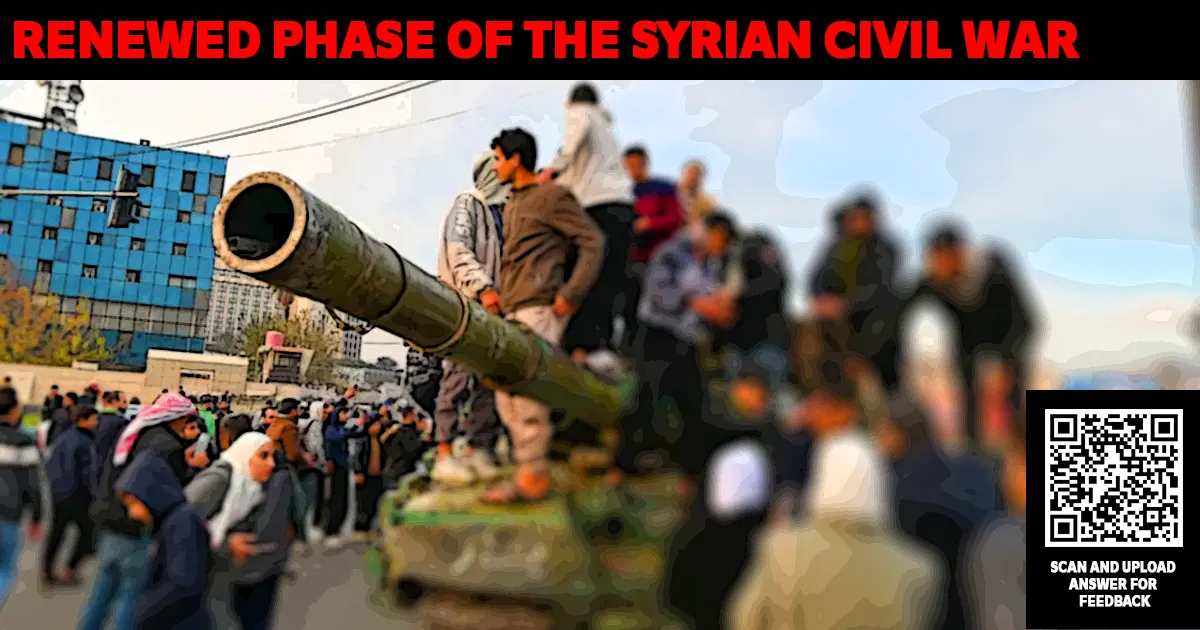GS2 IR

Context:
In late November 2024, Syria’s “Military Opposition Command” initiated a large-scale offensive against Assad’s forces, reigniting conflict in the region.
Travel Advisory:
India’s Ministry of External Affairs has cautioned against all non-essential travel to Syria due to heightened risks from the escalating violence.
Background:
The Syrian Civil War, active since 2011, has been marked by cycles of intense fighting, shifting alliances, and temporary ceasefires, with the last significant ceasefire occurring in 2020. The renewed conflict coincides with Russia’s strained military capabilities due to its involvement in Ukraine, reducing its support for Assad. Turkey’s actions in northern Syria, including its backing of opposition factions, have further destabilized the region. Additionally, Israeli strikes have weakened Hezbollah, a key ally of Assad, reducing his regime’s capacity to maintain control.
Key Actors in the Conflict:
- Hayat Tahrir al-Shaam (HTS):
- A militant group formerly aligned with al-Qaeda, rebranded in 2016 under Abu Mohammad al-Jolani to focus on local goals.
- Labeled a terrorist organization by the US in 2018, it operates with regional priorities and political complexity.
- Syrian Democratic Forces (SDF):
- A Kurdish-led coalition managing northeastern Syria, including areas like Deir ez-Zor and Raqqa.
- Initially formed to secure Kurdish autonomy and combat ISIS, it is currently under pressure from Assad’s forces, Turkey-backed militias, and HTS.
- Syrian National Army (SNA):
- Established as the Free Syrian Army in 2011 by Syrian military defectors, it now opposes both Assad and Kurdish groups, with Turkish backing.
- Collaborates with HTS through the “Military Operations Command” created in 2019.
External Stakeholders and Their Roles:
- Turkey:
- Aims to counter Kurdish militias and weaken Assad’s regime.
- Conducts military operations to create a buffer zone in northern Syria, using proxies to challenge the Kurdish SDF, which it links to the PKK.
- Iran:
- A steadfast ally of Assad, providing support through proxies like Hezbollah.
- Israeli attacks on Hezbollah have reduced its ability to bolster Assad’s regime.
- Russia:
- Assad’s primary military supporter since 2015, shifting the war’s trajectory in his favor.
- Its involvement in Ukraine has limited its ability to provide effective support in Syria.
- United States:
- Provides support to the SDF and continues anti-ISIS efforts.
- Maintains a delicate balance between opposing ISIS and managing geopolitical tensions with Turkey.
Challenges for Assad’s Regime:
- Diminished Control: Northern regions remain under Turkish influence, limiting Assad’s authority.
- Geopolitical Vulnerability: Despite Assad’s reacceptance into the Arab League, his regime faces continued opposition and external threats.
- Cautious Policies: Assad’s restrained stance on Israel and careful regional policies reflect his efforts to avoid further destabilization.
Regional and Global Responses:
- Arab States: Focused on curbing Turkey’s influence while striving for stability in the region.
- India: Supports Assad’s regime in alignment with Russia, while warning citizens to avoid travel to Syria due to the escalating conflict.
Future Directions:
- Diplomatic Efforts: Greater involvement by regional powers like Saudi Arabia and the UAE to prevent further escalation.
- Regional Stability: Countries need to manage alliances to balance Turkey’s influence and counter Russian and Iranian involvement.
- Humanitarian Aid: Immediate international assistance is critical to address the humanitarian crisis caused by the renewed violence.
[box] Discuss the factors contributing to the renewed phase of the Syrian Civil War in 2024. Analyze the roles of internal and external stakeholders in the conflict and their implications for regional stability and international relations.
[button color=”purple ” size=”medium” link=”https://forms.gle/Wzz7M6oVE4bQS8Ws8″ icon=”” target=”true”]Upload Answer[/button]
[/box]




